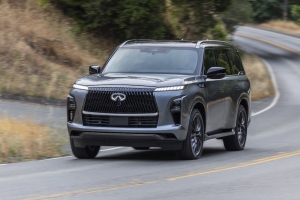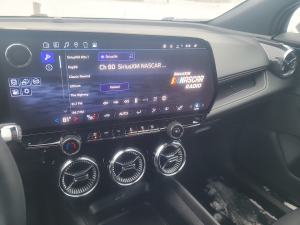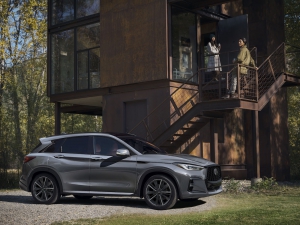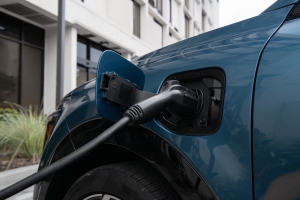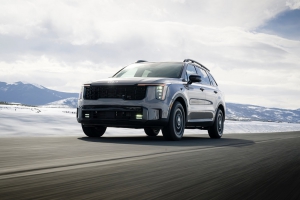
Matt M. Myftiu
Matt Myftiu has been a journalist for two decades with a focus on technology, NASCAR and autos.
2025 Kia K4 shows brand’s commitment to compact sedan segment
While much of the world continues to obsess over SUVs and trucks, it’s easy to forget that some individuals and families still need a small, affordable car.
This is why vehicles like the brand new 2025 Kia K4 — a brand new compact sedan that replaces the Forte in Kia’s lineup — exist.
I recently tested a 2025 Kia K4 GT-Line Turbo model, which showed me that a small vehicle can still have a lot to offer.
Read on for a full breakdown of how this vehicle measures up in a battle against compact sedan stalwarts such as the Honda Civic, Toyota Corolla, Mazda3 and Hyundai Elantra.
Land Rover Defender: 5 Things To Know
The Land Rover Defender fills a unique place in the automotive landscape — living somewhat of a double life.
It’s wholly built for tackling the off-road trails, but also has the composure to serve as a comfortable daily driver inside city limits.
It’s also more upscale in design than other off-road vehicle options such as the Jeep Wrangler and Ford Bronco.
I recently spent some time behind the wheel of a Land Rover Defender, and here are 5 key things to know if you are considering taking one home.
Redesigned 2025 Infiniti QX80: 5 Things to Know
Fans of the Infiniti brand have spent a long time waiting for an updated design on its largest SUV, and it’s finally here. And I’m not exaggerating, as the QX80 — Infiniti’s big three-row whale — hasn’t seen a full redesign since 2011, which is 14 years if you’re counting.
For the 2025 model year, Infiniti has made major updates to the exterior, redesigned the interior, changed out the engine, implemented major tech upgrades, and hopes to become more competitive vs. key luxury rivals such as the Cadillac Escalade, Lincoln Navigator, BMW X7, and Lexus LX.
The bold, long-anticipated redesign of the QX80 delivers. A great tech setup and roomy interior makes this a solid luxury SUV competitor once again after some down years.
This is the flagship ride for Infiniti, so it’s good to see it return to glory after some down years while rivals made improvements.
Read on to learn 5 key things you should know if you’re considering taking home the new 2025 Infiniti QX80.
1.
Strong tech upgrades
Technology is among the most important considerations for many car buyers these days, so Infiniti knew it had to come strong with the infotainment setup in the 2025 QX80 and significantly improve what the previous generation had to offer.
They succeed in doing so, with a massive new 14.3-inch screen up top in the center that is bright and clear, customizable, offers multiple tiles for various pieces of information, and is responsive to touch commands. There’s also another 14.3-inch screen in front of the driver showing key gauges and information.
A second 9-inch touchscreen in the center console controls climate function and drive modes, and is responsive to inputs with haptic feedback. This section is also well-designed and user-friendly, and the buttons to shift gears are among the very few physical buttons in this touchscreen-heavy vehicle, making the QX80’s new design quite high-tech and forward looking.
Beyond all that, voice commands can be used and are effective, with the vehicle understanding commands clearly. A wireless phone charger is also well placed in the center console. All in all, you get a major improvement over past Infiniti tech setups. Google Maps, Google Play app store, and Google Voice Assistant are all included.
Klipsch sound systems boom loud and clear in the QX80, with 14-speaker and 24-speaker versions offered.
In terms of safety tech, you get the latest ProPilot Assist system for self-driving on highways and other scenarios, plus the usual helpful features we’ve come to expect on these big rides — such as forward collision warning, automatic emergency braking with pedestrian detection, blind-spot monitoring, lane departure prevention and many more.
The birds-eye camera offered in the QX80 features 3D surround-view monitoring with motion detection, plus an ultra-wide front angle that will help you maneuver in and out of tight spaces.
All safety systems are responsive and warn of potential danger, yet are not overly sensitive. Last but not least, the ProPilot Assist self-driving system worked well to steer the vehicle. But steering wheel controls in the QX80 were a bit wonky to activate this feature.
2.
Spacious interior
A truly versatile family vehicle, the 2025 Infiniti QX80 offers an extra roomy interior, with seating for 7 or 8, depending on configuration.
The QX80 upgrades its interior setup for 2025 and is now more spacious in all 3 rows, even the rear seats, which both kids and adults can fit into comfortably.
Whether hauling cargo or lots of people, the new QX80 has you covered well.
The amount of cargo space is impressive, with 101 cubic feet available with the 2nd and 3rd rows down, 59 cubic feet with the rear row down, and 22 cubic feet with all seats up.
You can access the third row with the simple push of a button on the second row seats, which moves the seats forward to allow entry. Lowering rear seats can be done through a button in the rear of the vehicle to maximize cargo space.
Infiniti’s interiors used to be among the best in the luxury business, but had been sliding a bit in recent years. The redesigned QX80 brings it back to its status as one of the more high-end vehicle interiors you’ll find anywhere, period.
Beyond the high-quality semi-aniline leather, you can also get massaging seats in both the first and second rows, which is rare, plus a tech-savvy design and attractive trim features. There’s also plenty of small storage areas and cup holders throughout the vehicle, and lots of charging ports for the whole family that will come in handy on road trips.
Ambient lighting options include 64 different color choices, and you can even cool down drinks in the center console.
As a whole, the 2025 QX80 looks and feels truly luxurious, and recent model years had lost that feeling. It's back to its glory days in terms of prestige.
3.
Design upgrades
Redesigned for 2025, the Infiniti QX80 is one of the most recognizable large SUVs on the market right now. The first thing that jumps out at you is the bold new look up front — an in-your-face grille, paired with a unique lighting setup, that manages to maintain a bit of a classy design and a bit of sleekness.
Large wheels are included, coming in at 20 or 22 inches. The overall look of the QX80 is not as flashy as some rivals, but still very pleasing to the eye.
Side running boards allow everyone, even short adults and children, to easily access this big ride. It’s also important to note that the QX80 is a very heavy vehicle, weighing in around the 6,000 pound range, and measuring around 17 feet long and 80 inches wide.
The way these super-sized SUVs are designed is so high up, you feel like king of the world when you’re behind the wheel, and all other vehicles look like miniature toys.
4.
Powerful engine
To move a beast of a vehicle like this, you need a quality engine.
Infiniti has provided just that, with all trim levels featuring a powerhouse 3.5-liter, twin-turbo V-6 engine pushing out 450 horsepower and 516 pound-feet of torque, paired with a 9-speed automatic transmission.
This turbo V6 replaces the former V8 power plant in the QX80, and it provides a significant upgrade from past models.
Most trims also feature an impressive air spring suspension that boosts ride quality. The QX80 comes with rear-wheel drive on lower trims (Pure and Luxe), and all-wheel drive comes with the Sensory and Autograph trims.
Even with the size of the QX80, this motor gets you moving 0-to-60 in just over 6 seconds, which is respectable. For a massive ride, the speed and handling is quite impressive, both on highways and main roads. You know you are driving a large SUV but it is not unmanageable or difficult to maneuver.
The QX80 feels fast, brakes well, and the suspension impresses, all the while staying very quiet inside the vehicle. Overall I would say the QX80 is a bit less fun to drive than some rivals, but still offers a solid drive quality.
It also offers impressive towing capabilities at 8,500 pounds, a competitive number among the remaining body-on-frame SUVs. Drive modes include: Personal, Standard, Eco, Sport, Tow, and Snow.
5.
Disappointing fuel mileage, high price tag
Being an extra-large vehicle, fuel economy is going to be one area where the QX80 suffers.
The official numbers listed are 16 city/20 highway/18 combined on the RWD model, and 16/19/17 on the AWD version.
With a tank size of roughly 24 gallons, that will provide nearly 500 miles of highway range if you can achieve those numbers.
In reality, though, the numbers didn’t work out that well in my testing. I averaged about 13 mpg through a mix of city and highway driving. While these are disappointing numbers, even in this segment, fuel mileage is likely not the deciding factor for most buyers in this price range.
The other major downside to the QX80 is of course the price tag, as luxury full-size SUVs tend not to fall on the inexpensive side.
Starting around $84K is a high entry point, but if you’re looking for a bright spot, it starts out lower than rival full-size luxury SUVs from BMW, Land Rover and Cadillac.
And if you max out the QX80, you can reach into the $110K range, but some rivals blast far past and into the $150K+ realm, making it a bargain if you look at it that way.
Warranties are competitive, including:
— Overall warranty covers four years or 60,000 miles
— Powertrain warranty covers four years or 70,000 miles
— Free scheduled maintenance for three years or 45,000 miles
===
AutoTechReviews.com can be found on Twitter @AutoTechReview, or stay updated at the AutoTechReviews Facebook page. Follow AutoTechReviews on Instagram at @Autotechreviews or on TikTok at @AutoTechReviews.. Matt Myftiu can be found on Twitter @MattMyftiu.
2025 Chevy Blazer EV: 5 Things to Know
While it’s currently a time of tumult for the EV marketplace, and many automakers are re-imagining their strategy in the EV realm, some automakers remain committed to this transition.
Among its EV lineup, GM is in the second year of offering the Chevrolet Blazer EV, and I was recently able to get behind the wheel of a 2025 Blazer EV to see how the midsize SUV offering holds up in the EV landscape.
Below are 5 key things you need to know about the 2025 Chevy Blazer EV — which takes on heavy electric SUV competition from Tesla, Kia, Honda and others.
1.
BOLD DESIGN, ROOMY INTERIOR
The exterior design of the Blazer EV is bold in nature, front its standout grille to its eye-catching wheel designs. Speaking of wheels, sizes available to buyers range from 19 inches to 22 inches.
The Blazer EV walks the line between trying to look rugged while still maintaining a sleek side, and its design stands out in the current class of electric SUVs.
The only downside relating to the design is that the view out of the rear is a bit compromised due to a small rear window.
Moving inside, the 2025 Blazer EV features an extremely roomy interior for its class, and comfortable, high-class seats for all 5 passengers. Overall quality of interior materials is solid.
If you use the Blazer EV’s seat warmers, you’ll find they get things heated up quite quickly, and the dashboard design and tech setup is among the most attractive you’ll find in the segment.
Cargo space clocks in at 25.5 cubic feet with rear seats up, and 59.1 cubic feet with those seats folded down. These are competitive numbers in the segment but fall below capacity of some rival EVs.
2025 Infiniti QX50: 5 Things to know
As buyers start to enter the luxury realm, they have to begin their journey somewhere — and typically these days that’s with a compact luxury SUV.
Everyone from BMW (X3) to Mercedes-Benz (GLC) to Genesis (GV70) and more offer solid offerings in the category, but one brand that’s been there a while and continues to offer respectable offerings is Infiniti.
I recently spent some time behind the wheel of the 2025 Infiniti QX50, the brand’s smallest SUV offering.
Read on to learn 5 key things you need to know if you’re considering the QX50 as part of your search for a luxury ride.
1. Sharp design
On the outside, the QX50 features bold styling, including a no-nonsense grille and standout lighting designs.
Wheels are offered at 19 or 20 inches and in flashy designs, sidelines have a sleek look, and despite its age (last redesign in 2019), the QX50 is still a looker — portraying itself as muscular, but not ridiculous or gaudy.
Moving inside, the QX50 is a comfortable, roomy vehicle for all five passengers. Infiniti continues to make among the most attractive and comfortable interior designs in the luxury segment. My test vehicle featured attractive two-tone red and black leather seating, and plenty of legroom in the back seat compared to rivals in the compact segment. It feels bigger than its class, and the materials are high-quality, though perhaps a bit less luxurious than some rivals.
ARaymond’s Brenda Lee speaks about growing role of women in manufacturing, STEM fields
As we prepare to celebrate International Women's Day on Saturday, March 8, we spoke with Brenda Lee, a Process Development Technician for global fastener supplier ARaymond at their North American headquarters in Rochester Hills, Michigan. Brenda, who grew up and lives in Flint, Michigan, shared insights into her role at ARaymond, her journey in the manufacturing industry, and her perspective on what the future can hold for women entering the manufacturing and STEM industries.
Q&A with Brenda Lee, Process Development Technician at ARaymond
Q: What do you do at ARaymond? And what’s a typical day like in your job?
Brenda Lee: In my role as a Process Development Technician, I focus on optimizing and improving manufacturing processes. A typical day involves analyzing current production methods, identifying areas for enhancement, and implementing solutions to ensure efficiency and quality. This includes collaborating with die setters who set up the tools, after which our team processes the jobs, making necessary adjustments to achieve the desired outcomes.
Q: Can you tell us about your career path and how you arrived at your current position?
Brenda Lee: I joined ARaymond in 1998 after working at another automotive supplier, where I was involved in bumper assembly. When I first arrived, there were distinct roles for men and women, but I was determined to break those barriers. Despite being told I couldn't handle certain tasks, like lifting materials or die setting, I took the initiative to learn them and prove myself. Over time, I progressed from a production technician to materials handler, then to die setter, and now to Process Development Technician.
Q: What inspired you to pursue a career in manufacturing?
Brenda Lee: Originally, I studied criminal justice in college, aiming to follow in the footsteps of my grandfather, a police officer, and my uncle, a paramedic and firefighter. However, after witnessing some of the harsher realities of that field and heeding my grandfather's concerns, I decided to pivot. A cousin introduced me to opportunities in manufacturing and I found a new path that has been both challenging and rewarding.
Q: How has being a woman in a traditionally male-centered field impacted your career?
Brenda Lee: Navigating a male-dominated industry has certainly shaped my career and personal growth. Facing skepticism and resistance, I became more determined and focused. There were instances where my capabilities were doubted, and I had to continually prove myself. This journey has made me stronger and more resilient, but it's also highlighted the need for equal recognition and opportunities for women in the field.
Now with all the changes in recent years, there’s much more diversity in this field, but it was a struggle along the way. There were people who felt I didn’t belong. But as a self-taught and determined learner, I’ve managed to continue my growth in the industry. To me, it was the first time I was told “No, you can’t do that” that got me motivated. I was determined to make it work.”
Q: What advice would you give to young women considering careers in engineering or manufacturing?
Brenda Lee: It's essential to cultivate determination and resilience. Challenges and naysayers are inevitable, but using those obstacles as motivation can drive you forward.
Also, don't be discouraged by physical demands; there are always tools and methods that can make you work smarter and overcome those obstacles. Most importantly, believe in your capabilities and don't let others define your potential.
The biggest thing for me for women in the industry is a “mind over matter” mentality. You have to set your mind straight, and whatever is thrown at you, whatever people say, let it go, and use that as motivation to get to where you’re going.
Q: What are your career goals going forward?
Brenda Lee: I enjoy my current role as a Process Development Technician, but my next step to advance my career would be a supervisor role, and that’s an eventual goal. I’ve filled in for those roles in the past.
Q: How can the industry support and retain more women in STEM roles?
Brenda Lee: Encouragement and support from management are crucial. Providing women with the necessary tools, training, and opportunities to advance is essential. Early exposure to STEM programs can spark interest, but continuous support and mentorship are key to retention. Creating an environment where women's voices are heard and valued will foster innovation and diversity in the industry. I also encourage men in the workplace to speak up if women are being undervalued, as that can have a major impact.
I would also say to parents who have daughters to teach them at a young age that it’s OK for girls to be in sports and other activities that tend to be more male-dominated. Teach them to be a confident and strong-willed young woman, to be determined, not give up so quickly, and have an inner drive to get ahead.
Q: What efforts is ARaymond making to inspire and support women in STEM professions?
Brenda Lee: ARaymond has been moving in a positive direction with an approach that emphasizes fairness and diversity. There's a conscious effort to encourage women to pursue various roles within the company and to provide the support needed for their growth and development. There’s a recognition that women’s voices need to be heard, and their input taken seriously.
Kia Niro plug-in hybrid offers solid range, attractive design
The middle ground of plug-in hybrids remains an attractive proposition for people who want some electric juice in their vehicle, but don’t want a full EV so they aren’t completely reliant on charging.
Plug-in hybrids, like the entire EV industry, are doing their best to keep costs down, but it’s a constant battle.
Thankfully, a few vehicles that come in plug-in form are managing to stay somewhat affordable. One of these is the Kia Niro PHEV, a plug-in hybrid compact SUV which I recently had the chance to test, and starts around $35K.
The Niro is a rarity in today’s automotive market — as it’s offered a huge number of vehicle options, including:
— Gas-only
— Traditional Hybrid
— Plug-in Hybrid
— Electric Vehicle
This small, agile vehicle is a solid offering — especially for buyers who don’t transport lots of people or cargo, and may need a smaller vehicle for city maneuvering.
Read on for a full report on how the Niro PHEV fits into the current state of EVs and hybrids — including competition from the Hyundai Tucson plug-in, Ford Escape plug-in, Toyota RAV4 plug-in and Mitsubishi Outlander plug-in.
Dale Earnhardt Jr. and JR Motorsports joining Cup full-time would be huge boost for the sport
Despite the chaos at the end of the Daytona 500, there were a few positive stories to come out of the race.
Perhaps the best one was a top-10 run from JR Motorsports Xfinity Series driver Justin Allgaier, who made the team’s first ever start in the Cup series after racing his way into the 500 via Thursday’s Duels.
An owner in the Xfinity series for two decades, Dale Earnhardt Jr. — who is arguably the most famous NASCAR driver today despite being retired — would shake up the sport in a truly positive way if he does make the move up to Cup in the coming years.
And it’s something he is finally admitting some interest in doing.
"I think this helped me understand that I do want to be in the Cup Series, personally," Earnhardt said after the 500. "I do feel like that it's what I should be striving for. JR Motorsports loves being in the Xfinity Series, and we got a great business model, and we think we do a great job there. It would be a big challenge, but something Kelley and I could put a lot of effort into for the next several years."
That should be news to fans’ ears, who would love the see the Earnhardt name back in the Cup series on a full-time basis for years to come. Dale Jr.’s fans of course remember him driving for his dad’s Dale Earnhardt Inc. for the first half of his career, and this would be a truly welcomed addition to the Cup lineup across the board — especially now that Dale Jr. has emerged in retirement as one of the sport’s biggest mouthpieces and commentators.
Having that Earnhardt presence at the track every Sunday could be huge as the sport tries to draw the next generation of fans into the sport in the years to come.
Shorter-term, I wouldn’t be surprised if Dale and Kelley run Allgaier in a few more Cup events this season, assuming sponsorship is there to cover the costs. Regarding the purchase of a charter, I would anticipate they'll wait to see what happens in the antitrust lawsuit currently being litigated before committing to purchase any charters that may come up for sale, but it’s good to get their name out there even now as a potential buyer down the road.
Capable, well-designed Sorento fills important role in Kia’s SUV lineup
While other Kia SUVs are more likely to end up in the headlines, there are some lurking in the lineup that are also solid options for SUV shoppers to consider.
One such vehicle is the Kia Sorento, a three-row SUV that slots into the Kia SUV lineup just below the larger Kia Telluride and the smaller Kia Sportage, and comes in a variety of versions (two gas-only engines, a hybrid offering, and a plug-in hybrid).
Buyers seeking a high-quality three-row SUV, but whose budgets are too tight for a Telluride, are a key target of the Sorento.
I recently spent some time behind the wheel of a Kia Sorento X-Pro SX-Prestige model, and I’m back with a full report. (Note: I tested a 2024 model, but it carries over for 2025)
2025 Daytona Duels deliver joy for Bubba Wallace and Justin Allgaier, confusion for Erik Jones
Cup Series cars are back on track and racing for points, so all is right with the world if you are a NASCAR fan. Kicking off the action at Daytona on Thursday evening were the Duels, which helped set the lineup for the Great American Race on Sunday.
Bubba Wallace claims glory
Let’s start by talking about the first Duel, which ended with 23XI driver Bubba Wallace being the one to claim the checkered flag and take home his first victory at Daytona. A consistently strong superspeedway racer throughout his career, it was great to see Bubba finally deliver with a Daytona win, and it provides him with good momentum as he heads into Sunday and the big race. A win in the Daytona 500 would be a massive jolt for Bubba’s career, and the best possible start to the season. And after Thursday’s impressive run, he has put the competition on notice that he’s not here to run in the back of the pack on Sunday.
Wallace spoke after the race about his emotional evening at the Duel and the victory.
“What a good night. I didn’t know how it was going to play out, and we got the lead there and my McDonald’s Camry just switched like a light switch to a totally different balance from being in the pack. It was a little bit edgy out front, but luckily, I’ve got some years under my belt that people still trust me. I was lucky to have Tyler (Reddick) behind me – he did a great job pushing me. I appreciate that massive 23XI effort to get us this win,” Wallace said. “It sets us up really good for Sunday. We will enjoy this little moment right now. I told myself I would do more of – enjoy the little stuff. But hats off to these guys here. The best thing is – I cried when I walked out with (my son) Becks on pit road for driver intros, and it is really special to have him here. It is awesome.”
Team owner Denny Hamliln said he was impressed by the performance of both Bubba and teammate Tyler Reddick in the Duel.
“It’s awesome. Tyler (Reddick) was able to get a Duel last year and then Bubba (Wallace) this year. The 23 and 45 really controlled that race quite a bit so it was great to see. Even though they didn’t qualify (last night) where we expected, I think obviously the true speed of their Camrys really showed up tonight,” Hamlin said.
News Categories
Popular Tags
Search Reviews by Make

AutoTechReviews is your home for In-depth reviews of the latest cars, trucks, and SUVs; information on all the emerging vehicle technology; and breaking news from the world of NASCAR and other motorsports.


